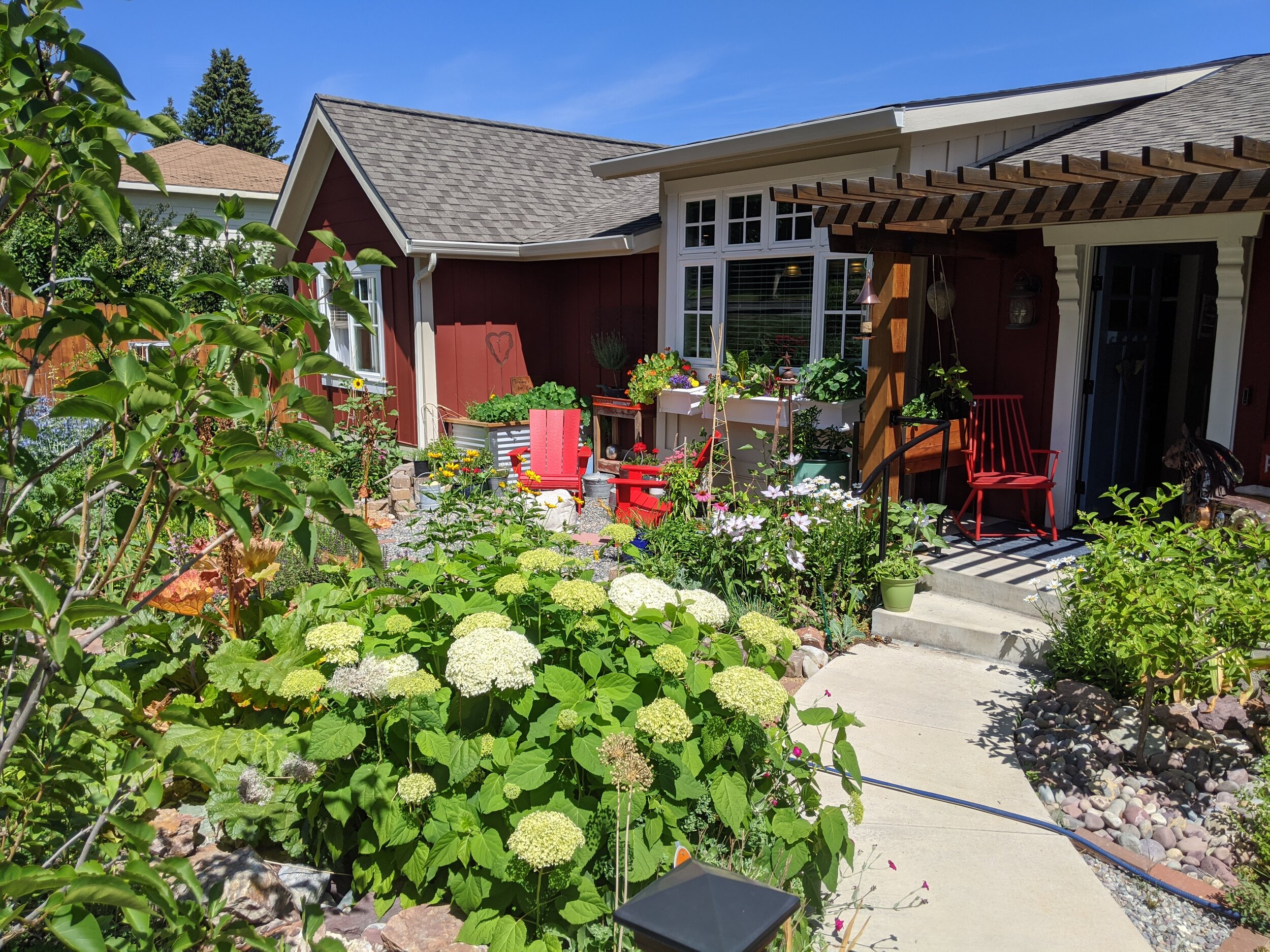Welcome to my never-ending project
“Garden as though you will live forever.”

In 2011, my husband and I moved into a house on a 12,000 square foot lot that had little more than a dead lawn and a few raspberry plants in the backyard. The yard is on the side of a mountain and the soil is thin at best. We are in agricultural Zone 4, with a frost-free season that stretches from June to mid-September.
Year by year, I dug up more dead grass, planted trees, bushes, and perennials, and built raised beds and a rock wall. I built a chicken coop and two gravel patios and reused a mess of old bricks to make a third patio. I lost track of how many loads of compost I had delivered, how much hay and garden soil I dragged in. I battled quackgrass and creeping harebell, learned to deal with the predation of rabbits and deer, and chased chickens out of the beds on more occasions than I can count.
I killed a bunch of stuff accidentally (grapevines and a “hardy” peach tree to name just two). I also gave away perennials that other people killed. It happens. Sometimes I kill something because I forgot where I put it and then accidentally bury it or dig it up. Doh! Every time I do that I swear it’s the last time, but it never is.
Along the way, I figured out what works for me. My love is flowers. I’m tired of stumpy and fibrous beets, carrots, and radishes; wimpy cucumbers; sad corn; and cabbages that serve as slug hotels.
I’ll happily buy most vegetables at the farmer’s market. I will grow lettuce, kale, zucchini, and tomatoes—oh, and broccoli, which I let flower before adding to salads or just munching in the garden. Don’t judge me.
I’m still deciding whether it’s worth it to grow strawberries, garlic, and peppers. I’d grow melons if I lived in Zone 6, but that’s a fantasy.
Gardening requires time, optimism, and work. Your garden needs YOU! I’ve watched many a piece of paradise go to ruin when a house changed hands. This includes my old garden.
You have to be willing to experiment to be successful. That’s part of the fun. One year, I had coddling moths in every apple. I wanted to combat them organically, so the next year I tied special stockings on the budding fruit. It took FOREVER and I still had coddling moths.
The next year, I ditched the stockings and covered the base of the tree with earthworm castings. It took 5 minutes and there were no moths. Was it causation or coincidence and is it even worth worrying about since the caterpillar eats very little of the apple and then departs? Some folks are fussy about a tiny blemish, I’m not. I’m using earthworm castings again this year because it might have worked and it’s a whole lot easier than tying on all those stockings.
That’s how it goes. Such questions can pique your interest or make you lose sleep depending on how you’re wired. It’s an exercise in patience and humility. You are not the cause of every failure in your garden, nor are you the reason for every success.
What I’ve got now
Trees. 18 fruit trees, mostly trained to grow flat against walls or fences, including 5 cherries, 3 pears, 3 plums, and 7 apples
Fruiting shrubs. Blueberry, bush cherry, currant, elderberry, gooseberry, honeyberry, and lingonberry
Canes. Blackberry and raspberry
Other Shrubs. Buffaloberry, forsythia, lilac, mock orange, peony, rose, and flowering plum
Perennials. Anemone, bee balm, clematis, chive, chrysanthemum, dahlia, daylily, echinacea, echinops, foxtail lily, hollyhock, honeysuckle, hop, hydrangea, hyssop, Karl Forrester grass, lady’s mantle, lavender, liatris, lambs ear, mint, oregano, oriental poppy, Queen Anne’s lace, ranunculus, rhubarb, rocket, rose campion, rudbeckia, sage, salvia, sea holly, sedum, shasta daisy, strawberry (including alpine), thyme, veronica, and yarrow
Bulbs. Allium, crocus, daffodil, garlic, iris, lily, and tulip
Annuals. Amaranth, ageratum, bells of Ireland, bread seed poppy, carnation, calendula, china aster, dara, cosmos, coreopsis, gomphrena, kale, lettuce, nasturtium, orlaya, scabiosa, snapdragon, sunflower, stock, sweet pea, zinnia, and zucchini





The front has no fencing and is visited daily by a herd of 6 to 9 deer. I’ll discuss the strategy for dealing with them in the journal.











If the earth laughs in flowers, my garden is a riot!
My Commitments
To my garden…
Local mulch (leaves, grass, hay, and shrub trimmings)
Local compost supplemented with chicken and llama poo
Drip irrigation
No-till gardening and the Ruth Stout method—reusing cardboard, covering bare ground, and helping the earthworms get busy
To the pollinators…
Blooms that extend over a full season and include native species
Uncut flowers that provide an uninterrupted food source
Chickens, earthworm castings, and good garden hygiene to keep pests to a minimum and tolerance of creatures that are just trying to get by (witness my giant anthill)
Flowing water and nesting spots provide the essentials






